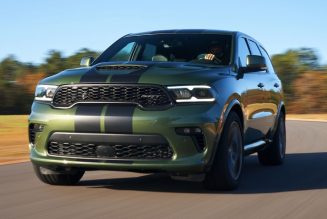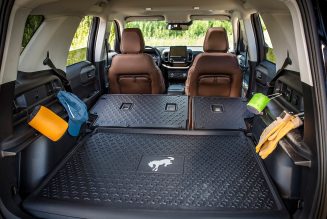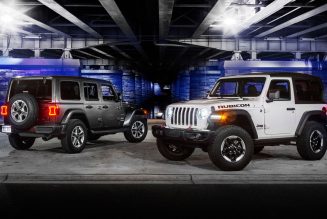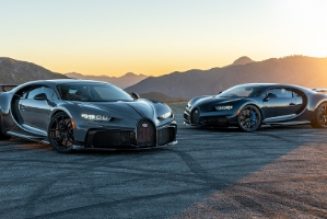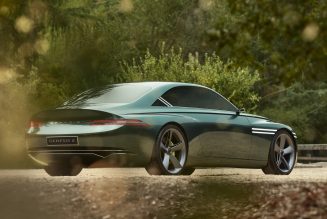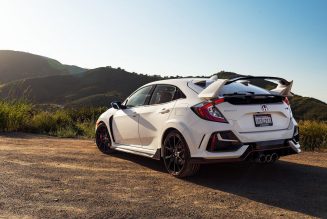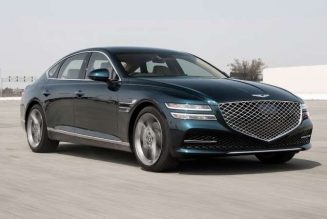We’ve been told that our cars must change, that they pollute and maim … and this can no longer be; Congress and DOT have decreed it. Some believe that this is only a phase we’re going through, that it, like all things, must pass. In our hearts, though, we know that it’s true and it really will happen. Still, those of us who love cars hope and work toward the end that there will somehow remain some trace of the excitement that we cherish in the breed of antiseptic transport modules that is to follow—vehicles conceived without emotion like test-tube babies in sterile laboratories. The Safety Cars are coming; we’ve already seen their ESV vanguard. Padding, periscopes, and airbags: the wave of the Future.
“The present-day concept of the automobile is outmoded. No longer can it be a work of art or a plaything; it must now be thought of as an instrument of use that can also kill and injure.” Amazing words, especially coming from Karl Wilfert, who in his 40 years at Daimler-Benz has designed, built, and driven some of the most exciting cars in the world. Wilfert is DB’s chief of body development and research (including styling) and is acknowledged as one of the most knowledgeable men in the world in the field of automotive safety. He also personally holds most of the Mercedes suspension patents and, with Rudolf Uhlenhaut, designed the 300SL on a kitchen table. The new 450SL (350SL in Europe) is his statement on what a car now must—and can—be.
The 450SL has significance beyond its appeal as a desirable or prestigious two-seater touring car. Its new fuel-injected 4.5-liter V-8 has already (with air pump and catalytic converter) met the tough 1975 emissions standards in the lab. Its basic body structure will accommodate bumper assemblies, designed already, that will meet Florida’s 5-mph standard, which Maryland has also adopted for 1974. DOT has stipulated 10-mph bumpers for its ESVs, and Mercedes probably has a good start on these as well. Additionally, it is almost a certainty that the interior design will be capable, with additional bolstering on the passenger side, of meeting DOT requirements for the protection of unrestrained occupants in a 30-mph barrier crash without airbags. “So what?” you ask. “The car costs nearly $10,000.” Yes, see it does, but its predecessor, the 280SL, with comparable equipment ran about $9,500, lending support to the argument that increases in safety need not bring huge increases in price. Even so, the new car has many overt improvements over the old, like the V-8, a three-speed automatic transmission with torque converter, and more advanced rear suspension, but the real improvements have been in making it substantially safer than the already very safe 280SL.
The Safe Bet
In a 1966 staff conference on safety, Dr. Wilfert presented a paper that has become the definitive work on the subject, singling out the automobile facet of the complex driver-car-road matrix that comprises automotive safety. In it, he discussed the concepts of active and passive safety, stressing the importance of the driver environment in active safety — the avoidance of accidents. He dealt with such things as the importance of good visibility, easily readable instruments, placement and design of controls, proper design of seats, and even air conditioning and ventilation to keep the driver alert. In a later paper, he discussed research done with hospitals in Sweden, where all accident fatalities become the property of the state for 48 hours, and autopsies are performed to determine the exact cause of death.
Indicative of the results was the fact that one doctor, who had performed over 300 of these autopsies, was able to tell by the injuries on the victim’s body the make of the car he had been riding in. This same doctor was able to determine and reconstruct the motions the body had undergone in the crash and what objects in the interior it had come into contact with. Particularly significant was the discovery that in a head-on crash, the driver tends to “submarine” under the dash while moving forward, hitting too hard with his knees and chest, while his abdomen continues forward, leading to spinal breakage. From this data, Dr. Wilfert was able to develop a steering wheel/steering column impact absorber combination that has markedly increased the survivability of the unrestrained driver in a frontal collision. (Forty-three percent of the accidents in the Swedish study, by far the greatest percentage, were frontal.) In the same way, it was determined that lives could be saved by devising a shift lever handle that was too large to penetrate the eye socket, and the new Mercedes have these. Gruesome stuff it’s true, but it must be faced.
When asked why he designed a new body for the 350/450SL, when the 280SL’s styling is still contemporary and attractive, Wilfert explained that, in truth, they could have face-lifted the 8-year-old car, but that it was really time for a change. The new internal air conditioning ducting, the bigger engine, the new European halogen headlights, new fuel tank location over the rear axle, and the aerodynamic changes to keep the side windows and taillights clean, required a new body shell.
Aerodynamics at Play
The attractively styled body is 3.4 inches longer and 1.4 inches wider than the 280SL. It continues Mercedes-Benz’s usage of what amounts to a monocoque structure, with no separate stub frame. The panels are punched out and the bodies welded together at the 360-acre Sindelfingen assembly plant, with a maximum production rate for the model of up to 70 a day. Of interest was the use of the Daimler-Benz-developed Elasto-Statik-Element-Methode (ESEM), which utilizes a computer to analyze each element of a structure in terms of its contribution to the total strength of the unit, an increasingly important consideration in maximizing strength without adding excessive amounts of unneeded material and weight. With ESEM, they have been able to increase the windshield post strength by 50 percent. Despite such techniques, however, the new car is about 275 pounds heavier than the old one. Approximately 150 pounds of this is in the body, with the change from aluminum doors (used in the 280SL) to steel accounting for 70 of those. The steel doors are of course necessary to provide requisite lateral crash protection. A set of front and rear 5-mph “Florida” bumpers will add another 120 pounds when they come along. (When I asked Rudolf Uhlenhaut if Mercedes would ever consider just writing off the U.S. market because of all the time and money required to meet the standards, he replied that it wouldn’t, because they just couldn’t abandon their sales organization and, even more important, that the Europeans would adopt the same standards as the Americans within two or three years. That’s one reason they went to the new gas tank location with double steel bulkheads; it isn’t required now, but they feel it will only be a matter of time before it is. My personal feelings are that the Daimler-Benz engineering department looks upon all of these current and proposed U.S. constraints as merely challenges to their ability, and it is their desire and will to engineer, coupled with enlightened management, that has made our automotive industry look like incompetent, footdragging naysayers by comparison.)
Much of the body development work was done with the aid of wind tunnel testing, permitting the design of the taillights such that they resist the buildup of road dirt to stay more visible. The corrugated ribbing along the lower body panels is more than a styling fillip, as it too came from wind tunnel work and contributes to keeping dirty water splashed up by the wheels from reaching and obscuring the side windows. In addition, the windshield posts have channels to carry the water coming off the wipers over the roof instead of across the side windows. In the past, Mercedes has been criticized for using high spring pressure to prevent the wind from lifting the windshield wipers at high speed, but here they accomplish it by having the wipers, with adjacent pivot points, running generally parallel to the airstream.
The cars built for the U.S. will carry air conditioning as standard equipment, providing draft-free cooling with ducting in the doors. ‘The same ducting is used for the defroster so that, along with the windshield and electrically heated backlight, the side windows can be kept clear. On the outside of the doors, a new pull-to-open handle is used which eliminates the push-button and the accompanying possibility of accidental door opening if the handle is stuck. The outside mirror is adjustable from the inside through a very simple control system and has a breakaway capability for pedestrian safety, but, unfortunately, will probably become a target for vandalism.
Comfort and Convenience
Although the impact absorber pad under the steering column has been standard throughout the Mercedes line, the four-spoke steering wheel is new. The padded hub, spokes, and rim are one piece and covered with molded polyurethane foam, which has a non-slip grained surface. The steering box is located behind the front axle and the column will collapse on impact. The windshield wiper control continues on the directional signal stalk, but now, in addition to the two speeds for the wiper motor, there is an intermittent mode. A large, central speedometer faces the driver, flanked by a tachometer on the right and a combo gauge with fuel quantity, oil pressure, and water temperature readouts, all easily interpreted.
The cars we tested in Germany carried the optional three-point shoulder harness with inertia reel, which will probably be standard here. They are very easy to fasten and release and permit the driver to lean forward as necessary to reach controls. The seats are comfortable and have enough aft movement to permit arms-out driving. Anchoring the belts to the seat frames assures proper restraint regardless of seat positioning. Ventilation is good, with driver and passenger each getting two dash-mounted vents.
We drove the cars at the Hockenheimring, which has several long straights, permitting speeds of up to 206 kph (128 mph), although it is difficult to evaluate a car under those conditions. Later, I was able to drive one of the 350SLs on the Autobahn and in town. at more normal speeds, with the Master Uhlenhaut himself, and found it quite nice. The Michelin tires on that particular car, though very good for handling, were noisy at highway speeds, and probably for that reason, the U.S. cars will carry Dunlops.
It’s a Cruiser, Not a Bruiser
The 350SL departs from the single-pivot swing-axle rear suspension used on the 280SL and uses an improved system, usually alluded to for some reason as “the BMW type rear suspension,” although it is Mercedes-Benz’s and is used on the New Generation (200-220-250) cars. In the case of the 350SL application, the rear suspension is stiffer. The car, in Mercedes tradition, has a lot of suspension travel, for a softer ride on rough roads, and only a limited degree of anti-dive and anti-squat. Uhlenhaut explains that more anti-dive could be added to the front end, but that it could have the adverse side effect of causing the wheels to “hunt” on extreme braking, putting added control responsibilities on the driver, who might already be in an emergency situation. The amount of anti-squat that can be added to the rear suspension, on the other hand, is determined by the geometry of the suspension, and a reduction of this would require new geometry or the installation of a complicated and expensive control device. The car has basic understeer because, as Uhlenhaut explains, “it is meant to drive on the streets, not on the track.” But it’s a good kind of understeer, the kind that forgives when you go into a tight corner too fast, and the car is completely predictable throughout any maneuver. The added front end weight of the air-conditioner, however, detracts from the basic handling. On the open road, the SL is a pleasure to drive, which again is probably part of the overall program to reduce driver fatigue. Throttle response in top gear at cruising speeds is far superior to the typical European standard, even with the 3.5-liter engine.
The power-boosted four-wheel disc brakes are very good and, as we predicted, Mercedes-Benz has chosen to introduce their Anti-Bloc Brake System on this car. The system, which can automatically apply and release each brake individually up to 15-20 times a second to produce minimum-distance skid-free stops under all traction conditions, will be an available option in early ’72, costing about $400. Mercedes has shown the system to all other European manufacturers in accordance with their policy of free access to this significant advancement. At the moment, BMW and Opel have expressed some interest and Volkswagen may offer the unit on their trucks. The system components are built by Teldix, an independent electronics manufacturer, and if production reaches 10,000 units per month, it may be possible to lower the price to $150
The 4.5-liter engine was not shown at the German preview in April, but it will probably be just an enlarged version of the SOHC 3.5-liter V8. The large engine will be available only in the U.S., at least initially, as it is designed to meet emissions requirements. It will be coupled with the new W3A-040 three-speed automatic. (Only a little over 100 manual transmissions were sold in the U.S. last year out of a total of over 29,000 MB cars.) It uses a 1,700-rpm stall-speed converter and has a torque capacity of 40 meter-kilograms (289 lb-ft). The transmission is tailored to the emissions control system of the engine. In the area of conjecture, it would seem logical that the 4.5-liter engine and W3A-040 transmission will replace the 3.5-liter V-8 and four-speed (K4C-025) transmission in all U.S. cars and might possibly supplant the 6.3-liter in the 300SEL Superwagen, all because of the emissions situation. Although this engine has met 775 standards in the laboratory, Uhlenhaut was quick to stress that the precise tolerances and adjustments necessary pose serious problems in achieving the same results in full production; but, at least, they’ve got a handle on the problem.
The 450SL will arrive here for sale in the fall (when it will probably be referred to as the 350SL 4.5 to prevent hard feelings in the home market), and we will most likely be able to test the actual car in July, bringing the results to you by the October issue.


